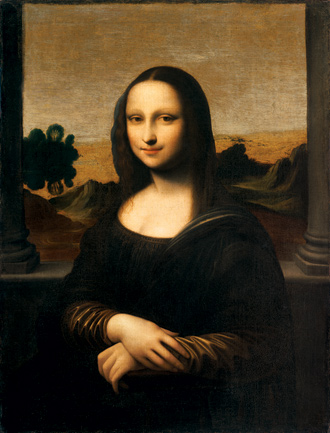
‘Earlier Mona Lisa’, c. 1503-1506.
In his masterwork, The Lives of the Most Excellent Painters, Sculptors and Architects, first published in 1550, Giorgio Vasari is particularly effusive about the way that Raphael’s work was influenced by Leonardo da Vinci. Raphael went to Florence in the early years of the 16th Century with the intention of studying great artists and took the opportunity of observing Leonardo at work on, among other projects, the portrait of Lisa Gherardini, the young wife of Francesco del Giocondo.
“ … after seeing the works of Leonardo da Vinci, who had no peer in the expressions of heads both of men and of women, had surpassed all other painters in giving grace and movement to his figures, he [Raphael] was left marveling and amazed; and in a word, the manner of Leonardo pleasing him more than any other that he had ever seen, he set himself to study it, and abandoning little by little, although with great difficulty, the manner of Pietro [Perugino], he sought to the best of his power and knowledge to imitate that of Leonardo. But for all his diligence and study, in certain difficulties he was never able to surpass Leonardo; and although it appears to many that he did surpass him in sweetness and in a kind of natural facility, nevertheless he was by no means superior to him in that sublime groundwork of conceptions and that grandeur of art in which few have been the peers of Leonardo. Yet Raffaello came very near to him, more than any other painter, and above all in grace of colouring.”
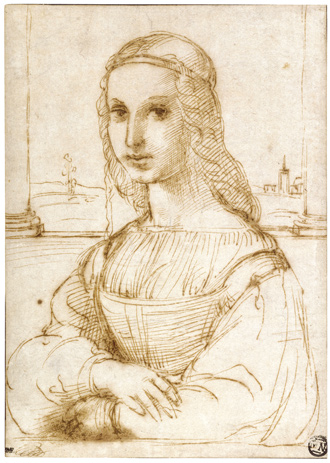
Raphael’s ‘Young Woman on a Balcony’, pen and ink sketch, c. 1504.
The subject of the Raphael Sketch is treated at length [See ‘Historical Evidence’], but is re-emphasised here to underline how the ‘Earlier Mona Lisa’ likely not only spawned numerous copies that today are revered in museums and exclusive collections around the world, but possibly also inspired one of the most extraordinary Renaissance artists to follow and experiment with innovative compositions. This demonstration represents significant evidence, as previously mentioned, that Raphael’s decision to come to Florence and study the works and methods of Leonardo paid a handsome dividend for which he was grateful – he revered Leonardo until his own death. It would seem that these images are specifically derived from the ‘Earlier Mona Lisa’, the one on which he was working at the time of Raphael’s visit. It is further evident that there is little artistic connection between these Raphael works and the Louvre ‘Mona Lisa’.
The deliberate structure of this composition, with its flanking columns; low-rise landscape in background; and obvious youth of the subject sitter (model), strongly suggest that it was the ‘Earlier Mona Lisa’ that Raphael had studied so assiduously. Together, these elements are unique to both works. In addition, Raphael copies the modern three-quarter pose, with head tilted slightly forward and eyes directed at viewer, and the pose of hands, with right hand gently resting on left, indicating modesty.
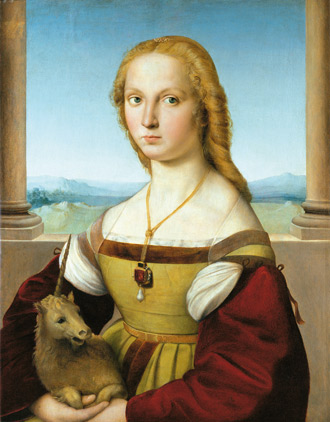
Raphael’s portrait of ‘Lady with a Unicorn’, c. 1505
Raphael takes his own pen and ink exercise, to the next dimension, with an exquisite formal portrait marking the betrothal of the young lady. Again, the composition is flanked by Ionic columns, beautifully rendered and so similar to those in the ‘Earlier Mona Lisa’. The low-lying background landscape is also similar, offering little distraction from the finely detailed brushwork and, in contrast to Mona Lisa’s relatively unadorned clothing, the subject’s rich dress and striking jewellery.
“The ‘alicorno’ or unicorn, through its intemperance and its inability to control the delight it takes in young maidens, forgets its fierce, savage nature and puts all suspicion aside, approaches the seated maiden, and goes to sleep in her lap; and thus the hunters take it.” Leonardo da Vinci, Ms H, fol. 11 v
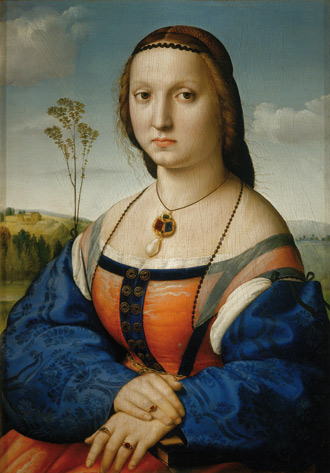
Raphael’s ‘Portrait of Maddalena Doni’, c. 1506
Here though the structure is similar, Raphael’s maturing experience is apparent in this unique version. The portrait is one of a pair depicting Maddalena Strozzi and her wealthy husband Agnolo Doni, painted shortly after their marriage. Raphael’s superb attention to detail, as in the jewellery and the fabric of the clothes, contrasts with the austerity of Leonardo’s later work.
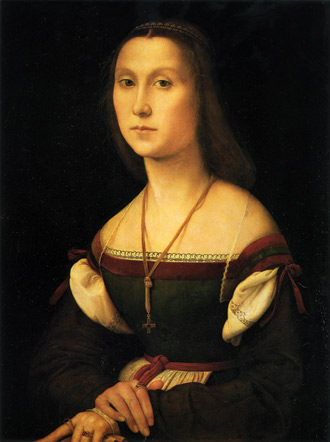
Raphael’s Portrait of a Young Woman -‘La Muta’, c. 1507-1508
In this sublime portrait of an unidentified lady, Raphael continues with the use of elements, notably the unique pose, as pioneered by Leonardo. Raphael exploits his own genius as a portraitist by taking the ethereal hands of Mona Lisa as the model, and by extending the subject’s left forefinger, creates a degree of dynamic realism.